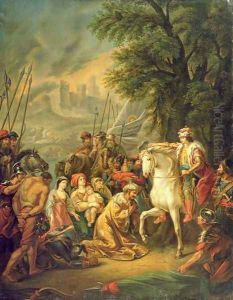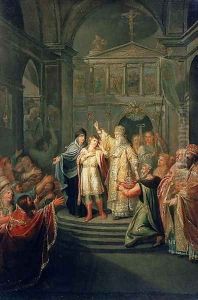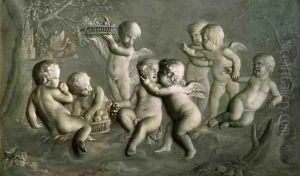Grigoriy Ivanovich Ugryumov Paintings
Grigoriy Ivanovich Ugryumov was a prominent Russian painter active during the late 18th and early 19th centuries. He was born on April 11, 1764, in St. Petersburg, Russia, into a family with a strong artistic background; his father, Ivan Grigoryevich Ugryumov, was a sculptor. Grigoriy Ugryumov's initial training began under the guidance of his father and was later supplemented by formal education at the Imperial Academy of Arts in St. Petersburg, where he studied under the tutelage of Gabriel-François Doyen, a French painter.
Ugryumov specialized in historical and religious paintings, adhering to the academic style that dominated the era. He was influenced by the neoclassical movement, which was prevalent throughout Europe at the time, characterized by a return to classical ideals of harmony, simplicity, and proportion. His works often featured dramatic narratives, a clear organization of space, and a focus on the human form, rendered with precise anatomical detail.
Throughout his career, Ugryumov received numerous accolades for his artistic achievements. In 1789, he was awarded a gold medal by the Academy for his painting 'The Resurrection of Jairus's Daughter.' Following this success, he was sent abroad to further his studies, spending time in Italy, which was a common practice for promising artists of the period. There, he was exposed to the works of the Italian masters, which had a lasting influence on his style and technique.
Upon his return to Russia, Ugryumov became a respected professor at the Imperial Academy of Arts, where he influenced a generation of Russian artists. He continued to produce significant works, many of which were commissions for the Russian Imperial Court or the Russian Orthodox Church. Among his notable paintings were 'Entry of Vladimir Monomakh into Constantinople' and 'The Miracle of St. George and the Dragon,' which exemplify his skill in depicting complex historical scenes.
Ugryumov's contribution to Russian art was not limited to his own creations; as an educator, he played an essential role in shaping the artistic landscape of Russia during a period of cultural growth and transition. His commitment to the academic traditions of art helped establish a framework for the professional training of Russian artists in the 19th century.
Grigoriy Ivanovich Ugryumov passed away on May 20, 1823, in St. Petersburg. His legacy endured through his students and the numerous works he left behind, which continue to be studied and admired for their embodiment of neoclassical principles and their reflection of the historical sensibilities of his time.


